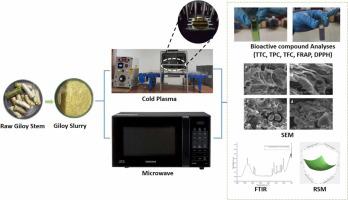Journal of Applied Research on Medicinal and Aromatic Plants ( IF 3.9 ) Pub Date : 2023-10-26 , DOI: 10.1016/j.jarmap.2023.100520 Sibasish Sahoo , Subhanki Padhi , Rachna Sehrawat , Winny Routray

|
Giloy (Tinospora cordifolia Miers.) is a well-known herbal medicinal plant that is therapeutically rich in secondary metabolites but is bitter in taste, thereby limiting its potential to be used as a functional food. Hence, this study was aimed at reducing the bitterness of giloy juice through cold plasma (CP) (10–30 kV, 10–40 min, CCD with 5 center points) and microwave (MW) (100–180 W, 5–15 min) applications, making it available in a more palatable form, which is quite a noble approach unlike already existing debittering methods like ultrasound and β-cyclodextrin incorporation methods. Bicyclic diterpenoids are the principal bitterness-causing element in giloy; hence, total terpenoid content (TTC) was taken as the gauging factor to scale the bitterness while targeting higher concentrations of various bioactive compounds (BCs) through FRAP, TPC, TFC, and DPPH radical scavenging activity assays. RSM is used to address the change in BCs’ content with respect to the influencing factors. A decrease in TTC in giloy juice was observed by 73% after a CP treatment of 30 kV for 25 min and by 26.5% in a MW treatment of 100 W for 15, which the FTIR results also corroborate. The physical surface morphology of the sample was found to be affected by the CP and MW treatments, as evidenced by the SEM images, which aided in the evaporation and diffusion of BCs and further variations in their functionality owing to the operating conditions. CP though was effective in reducing the TTC but MW was good at extracting terpenoids along with other BCs.
中文翻译:

微波和常压冷等离子体辅助吉洛伊(Tinospora cordifolia Miers.)果汁脱苦:对生物活性化合物含量的影响
心叶青牛胆(Tinospora cordifolia Miers )是一种著名的草本药用植物,其次生代谢产物具有丰富的治疗作用,但味道苦涩,从而限制了其作为功能性食品的潜力。因此,本研究旨在通过冷等离子体(CP)(10-30 kV,10-40 分钟,具有 5 个中心点的 CCD)和微波(MW)(100-180 W,5-15分钟)的应用,使其以更美味的形式提供,这是一种非常高尚的方法,与现有的脱苦方法(如超声波和β-环糊精掺入方法)不同。双环二萜是吉洛伊中主要的苦味元素;因此,总萜含量(TTC)被用作衡量苦味的衡量因素,同时通过 FRAP、TPC、TFC 和 DPPH 自由基清除活性测定来瞄准更高浓度的各种生物活性化合物(BC)。RSM用于解决BCs含量相对于影响因素的变化。在 30 kV 的 CP 处理 25 分钟后,观察到吉洛伊果汁中的 TTC 降低了 73%,在 100 W 的 MW 处理 15 分钟后,TTC 降低了 26.5%,FTIR 结果也证实了这一点。SEM 图像证明,样品的物理表面形态受到 CP 和 MW 处理的影响,这有助于 BC 的蒸发和扩散,以及由于操作条件而导致其功能的进一步变化。虽然 CP 可有效降低 TTC,但 MW 擅长提取萜类化合物以及其他 BC。



























 京公网安备 11010802027423号
京公网安备 11010802027423号